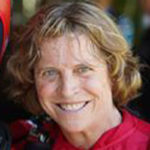Using Visualisation to plot your 3D course to your radial

Photo by Gary Wainwright
Quadrants and radials
As you dirtdive identify the quadrant your slot belongs to and design your dive and approach so that you enter in a straight line to your slot. Break the base into four ‘pieces of the pie’ when viewed as the full formation. Find your quarter, then eighth and follow a vector from the centre of your pie directly into your slot. If your slot does not face straight in, then treat it as if it is straight in, in terms of quadrant approaches. Make the final heading change once you are stopped and in your slot.

Radials
Image courtesy of P3 Skydiving
Diving
When diving down or floating up towards the base, do not dive blindly. The fastest way to the formation is always a straight line. Too many people confuse a perceived fast ‘down and over’ line with a straight line.

Identify your diving line upon exit and follow it to your quadrant to set up in your approach. It is always quicker to your slot this way even if it seems slower on a personal basis. You are only as fast as your teammates. There is no benefit in your being the fastest diver or floater. We are a team and as such we are as good as the sum of our abilities and talents.

Image courtesy of P3 Skydiving
Stadium
Large formation approaches are often compared to a stadium or ‘tea cup’ set-up. Each ring of non-docked people sets up approximately at a 30° angle. As the row in front of you moves down and forward toward their place in the formation, your row takes its place. This continues until your row is in the formation.
The size of the stadium varies. In a 400-way, the stadium can easily occupy 100 metres or more – up and out – from the base. The important thing is that the rows are clearly defined and follow each other down in an orderly fashion.

Photo by Norman Kent
Visualisation
1. Memory
There are various aids to help you remember your approach line and slot in the formation.
It is easier to remember two-word descriptions than longer ones. As you dirtdive notice and remember things that may stand out in freefall. Matching jumpsuits makes this procedure far more important than in ‘normal’ skydives. Use short descriptive terms that use differences in the containers or helmets of the jumpers on the load, eg ‘red Javelin’, ‘yellow stripes’ or ‘green G4’. Sometimes brightly coloured tape is used to identify helmets for critical slots. If you choose something common like ‘blue helmet’ or ‘red suit’ then you may find that there are more red suits in your approach pattern than you anticipated!! Body positions can also be used as descriptive terms. You can recognise people by their mantis or boxman positions on approach.
It is easier to remember two-word descriptions than longer ones”
2. Locations
Choose markers in the base and throughout the formation. Have at least one from a line docking behind you – then if you have a horrible exit and are late you can identify the strange people ahead of you! If you are in a trail plane some of your identifiers should be from a different aircraft so you can identify the line between the two aeroplanes. Six markers is probably about right.

Sequential Games, Skydive Perris 2019, photo by Gary Wainwright
3. Checklist
Take these identifiers and place them on a mental checklist in the order that you anticipate seeing them in freefall. The base marker may not be, and often is not, the first thing you will see on exit. Quite often it will be the marker from a different aircraft. Recite the mental checklist and make it part of your visualised dirtdives. If in freefall your first marker is not there, simply move to the next one on the list. Don’t fall into the trap of knowing you dock on a ‘red suit’ and making that your only visual reference – you will regret it when that red suit goes low or is lost.
Recite the mental checklist and make it part of your visualised dirtdives. Visualise Perfection”

Sequential Games, Skydive Perris 2019, photo Gary Wainwright
4. Identify People
It is easy to know that you are docking on a specific person if you have many jumps with them but they may look different in freefall. If your teammate has made even minor changes in equipment then you may find them difficult to identify. Finding out the names of those around you helps, remember them.
5. Visualise Perfection
Visualise your perfect skydive, from exit to canopy, then make it happen. Have the composure and ability to close your eyes and know who and what you expect to see in freefall throughout the jump. Visualising perfection is possibly the most important tool available to any skydiver, regardless of chosen discipline. Do it.
Big-way Bites Series
Previous article – Big-way Bites 1 – Exit
Next article – Big-way Bites 3 – Fall Rate

